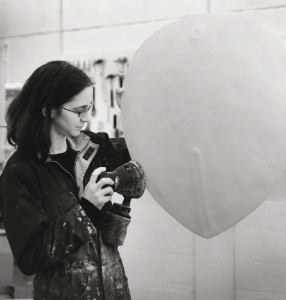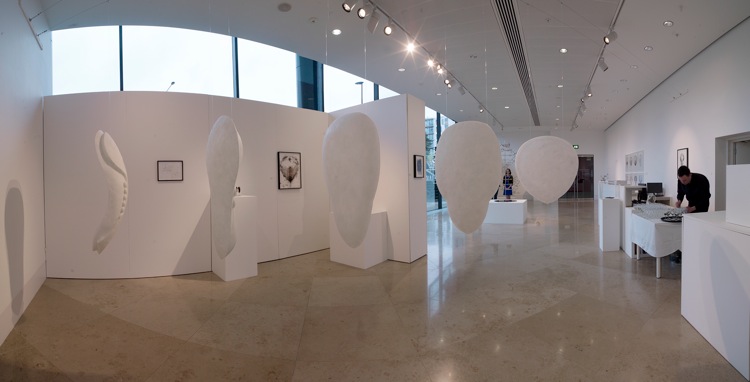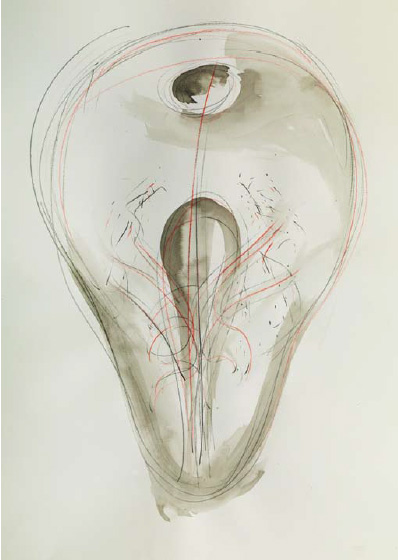In Embryology, the Carnegie Stages are a set of 23 stages used to describe the developmental chronology of a vertebrate from fertilisation to the point it becomes a foetus. When I was researching my embryogenesis work, I came across the early stages of human embryology and was amazed by these intriguingly simple and elegant forms that seem to come more from the canon of sculpture than the messy world of biology. Carnegie stages 6 and 7 remind me of early Greek sculptures from the Cyclades that were highly simplified human figures carved in marble. Carnegie stage 10 resembles the African Masks that were so influential to Picasso and Braque, and all of the ones that inspired me have echoes in modernist and minimalist sculpture of the 20th century.
As soon as I had discovered these amazing forms, I had a vision of the completed sculpture: five forms hanging in mid air that would show the progression from a simple disc to the beginnings of complexity. It was almost as if I was working with a ready made, but the real world objects I chose to convert to sculptures were on a microscopic level, so I would need to go through a sculptural practice to bring them into being.
Initially I worked small on five wax maquettes, each of which could sit easily in the palm of my hand. This allowed me to work rapidly and intuitively to understand the biological forms and turn them into sculptures. When I was happy with the set, I thought about the scale of the final work, experimenting with scale drawings and understanding the relationship to the human scale of the viewer. Having worked out my final pieces would be 12.5 times my maquettes, I decided to enlarge in a two stage process, as it would have been to great a leap to go straight from the maquette to the final size. Thus I created 5 plaster sculptures that were 5 times the scale of my maquettes. This allowed me to work slowly to fully understand the forms and how and why they worked. I refined them and their interrelationships over a period of about 4 months to produce a set of sculptures that are a similar scale to portrait heads.
The final stage was to enlarge my plaster works by a further 2.5. This was done in clay on large metal and wood armatures. Each of these was done in surprising speed, working the clay in a very loose way to keep the final texture of the works fresh. They were then moulded and cast in a new material, a bioresin that has a translucent quality reminiscent of cast glass. The final work was installed at Pangolin London in May 2013 as part of my first solo show ‘Life Forming’
CS6-10
CS6-10 is a large installation that show the early human embryo transform from a flat disk of cells, with its first line of symmetry (the primitive streak) into the beginnings of a complex form, complete with neural plate (early brain) and somites (markers for the vertebra of the spine). It also shows four ‘disk embryos’ followed by the final form CS10 in which the disk is starting to curl and curve into the more characteristic embryo shape. The size of each form is equivalent to a human body.
Bioresin
Edition of 3 (available for sale)
Total installation 2 x 2.5 x 2.75m
2013
Carnegie Stages 6 – 10
These plaster sculptures again represent the same five Carnegie stages but the scale is more equivalent to a human head. In reality the embryos range from microscopic 0.2mm (CS6) to just barely visible 3 mm (CS10).
Plasters for bronze
Edition of 8 (available for sale)
27.5 – 49 cm high
2013
CS 6-10 Maquettes
This bronze montage of the five maquettes for the series allows the viewer to pick up and remove each embryo from its mount, allowing it to be held in the palm of your hand.
Bronze
Edition of 25
13.8 cm high
2013
CS 15
This is an abstracted form of Carnegie Stage 15 of a human embryo. At this stage the limbs are still just buds and the embryo has a tail, but it already has a beating heart.
Jesmonite for bronze
Edition of 8
28 cm high
2013
Primitive Streak
This abstract sculpture was developed at the same time as the above Carnegies Stages 6-10. Where the latter are closely related to the biological forms, in this piece I investigated a line of symmetry as a creative act.
Jesmonite for bronze
Edition of 8
42 cm high
2013
Embryonic Heart Development Series:
CS6 – Heart Cells Migrating 2
The embryonic Heart Development series is a series of drawings that show how the heart is developing in the embryos as they move from Carnegie Stage 6 through to 10. In this drawing the heart cells that start forming either side of the primitive streak in CS6, start to migrate through the streak and down into the mesoderm of the embryo.
Ink & pencil on paper
Unique
59 cm high
2013
Embryonic Heart Development Series:
CS7 – Heart Cells Migrating I
This drawing shows the heart cells migrating across the embryo in carngegie stage 7.
Ink & pencil on paper
Unique
59 cm high
2013
Carnegie Stage 9
This cyanotype was created using the plaster carnegie stage 9 sculpture and the sun’s rays in a photographic chemical process. The chemicals where not fully washed out, allowing me to draw on the cyanotype using water.
Reworked cyanotype
Unique (in private collection)
55 cm high
2013
Carnegie Stage 10
This is a scaled drawing of carnegie stage 10 that was used in the process of scaling up the maquette to the plaster sculptures.
Graphite & chalk on paper
Unique
75.5 cm high
2013














